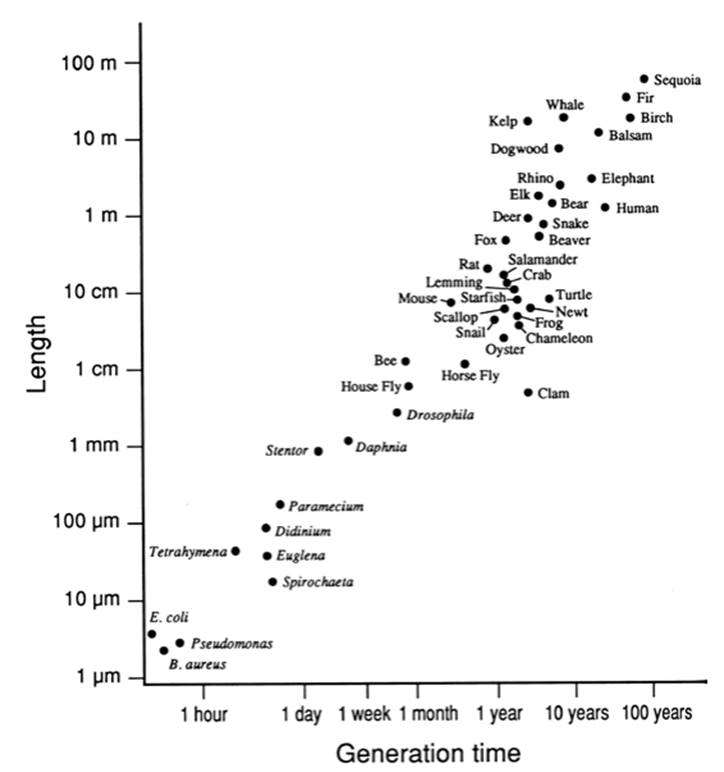Chronological Versus Physiological (Metabolic) Time
Increase in size can be viewed as an integral of steps through the life cycle; it follows that more steps, hence more absolute or chronological time, are required to produce a larger than a smaller organism. This in turn means that the generation time (Fig. 4.10) or the time to reach sexual maturity is usually longer, as must be life span in general terms, for larger organisms. Generation times range from on the order of a few minutes for bacteria growing under favorable conditions, to a few hours for protozoa, a few days for the house fly, about 20 years for humans, and about 60 years (albeit with high variation) for the giant sequoia.
This relationship has obvious implications for potential population density (next section) and for the amount of absolute time and number of environmental events that a generation of any given size-class of organisms experiences.

Fig. 4.10. The implications of size to reproductive potential: Lengths of micro- and macroorganisms versus their generation times. Redrawn from Bonner (1965); reproduced from Size and Cycle: An Essay on the Structure of Biology by John Tyler Bonner, by permission of Princeton University Press, ©1965
There is also another time scale, one that has a physiological basis and is size-dependent. As early as 1950, Hill speculated that all physiological events in an animal might be set by a clock that runs according to body size. Thus, small animals have a fast pace of life but do not live long. On balance, both the shrew and the elephant experience about the same number of physiological events or actions per life span (Chap. 6; see also Chap. 12 in Schmidt- Nielsen 1984).
Almost all biological times in birds and mammals (e.g., muscle contraction, blood circulation, respiratory cycle, cardiac cycle) vary with the same body-mass exponent (mean = 0.24; Lindstedt and Calder 1981; Brown et al. 2000), regardless of the tissues, organs, or systems involved. The relationship also holds for a range of life history or ecological times, for example, life span, time to reproductive maturity, time for population doubling. It follows that the ratios of any two biological times (e.g., respiration cycle:heart cycle, or time to reproductive maturity:blood circulation time) versus body size plot as a horizontal line (Lindstedt and Swain 1988).
In other words, just as the number of minutes per hour is constant in absolute time, so are biological activities per unit of physiological time: All mammals have 4-5 heartbeats per breath, and use about the same number of calories per unit weight per lifetime.
Because physiological time accounts for body mass, hence how each organism sees the world, in a way that absolute time cannot, it may be the most appropriate criterion for interspecific comparisons at least among warm-blooded animals (Lindstedt and Swain 1988; Lindstedt and Calder 1981). However, physiological time would appear to have little value in comparisons involving cold-blooded animals such as frogs, fish, and invertebrates. Their energy expended per unit time or maintenance metabolic rate is more variable and highly environmentally dependent.
Date added: 2025-06-15; views: 161;
